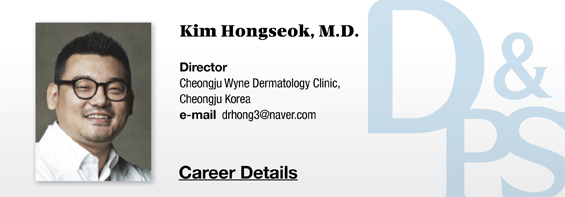
Licorice extract
Gabridin (Glycyrrhiza glaba) is a major component of licorice extract and is used in treatment of dermatitis, eczema, pruritus, and irritation, etc. It also has anti-mutagenic, anti-carcinogenic, and tumor suppressive capacity. Glavridin is used as a whitening agent and its whitening action comes from tyrosinzse inhibition without affecting DNA synthesis. Topical application of 0.5% glabridin was shown to prevent UVB-induced pigmentation and erythema lesions in guinea pig skin. With its suppression of superoxide anion and cyclooxygenase activity, glabridin was also found to have anticancer effect and improve melasma in an in vivo study. A study comparing glabridin with HQ found that glabridin had a superior whitening effect. In Europe, licorice extract is widely used as an anti-inflammatory treatment despite lack of scientific evidence of such action. Licorice extract added to a cosmetic product gives it an anti-inflammatory effect. Retochalcone licochalcone A (LicA) has shown anti-inflammatory, antibacterial, antiparasitic, and anti-tumorigenic activities. It was found to be also effective in rosacea and protect against oxidative stress from ROS[i].
Melanosome-transfer Inhibitors
Niacinamide
Nyacinamide (C6H6N2O) is a commonly used whitening agent in cosmetic products. It is a physiological amide of Vit B3 and is also known as nicotinamide. It has anti-inflammatory and anti-oxidative effects and prohibits melanosome transfer to epidermal keratinocytes. In an in vitro model, it was found to inhibit melanosome transfer up to 68% and improve facial pigmented lesions. Hyperpigmentation was shown to significantly improve after 8 weeks of twice daily use of 5% niacinamide or 3.5% niacinamicde+retinyl palmitate. Niacinamide has thermal and photo-stability and can be used both day and night. The MFDS of Korea reported that it has whitening action at a 2% concentration. It is effective as a moisturizer in acne, melasma, atopic dermatitis, rosacea or psoriasis due to its anti-inflammatory action and oral intake of niacinamide can prevent nonmelanoma skin cancer[ii].
A study comparing twice daily application of 4% nyacinamide gel and 1% clindamycin gel in acne found similar results. Acne patients benefited from long-term use of 82% niacinamide gel and did not develop tolerance[iii]. Topical application of nyacinamide combined with Vit. C, Vit. E, and Vit. A was beneficial in photo-aged skin[iv].
Moisturizers containing nyacinamide help alleviate dry skin and recover the barrier function of the stratum corneum. However, the exact mechanisms of these actions are not clearly understood yet. Twice daily application of a nyacinamide-containing product for 1 month reduced TEWL and improved the surface and maturity of the stratum corneum. It also reduced protease (KLK5·KLK7·tryptase·plasmin) activity, and improved skin thickness. It is expected to open a new chapter for a topical agent that will effectively improve skin barrier function[v].
HELIOSⅡ/LOTUSⅡ/HYPERION – Manufacturer: LASEROPTEK(www.laseroptek.com)
Soy
Soybean belongs to Leguminosae and is rich in tofu, beans or soy milk. Soy started being used in skin care products after many women working at tofu factories in China were found to have healthy skin. PAR-2, and G-proetin-coupled receptor are needed to control melanosome ingestion by keratinocytes. Paine et al. showed that soy milk and Soybean Tryosin Inhibitor (STI), Bownam-Birk Inhibitor (BBI), two soy-derived proteins inhibited PAR-2 activity and brought skin whitening[vi]. Soy’s whitening action and inhibition of UV-induced pigmentation was proven in both in vitro and in vivo studies. In this study, F&M staining of depigmented skin showed that treated skin had less melanin deposition. This effect was found only with fresh soy milk and not with fermented soy milk. In humans, topical application was also found to lighten darker spots[vii].
A recent study showed that a soy moisturizer containing non-degraded STI and BBI partially improved the skin tone and signs of photo-aging. In 65 women aged 30-61 years with mottled hyperpigmentation, lentigine, Fitzpatrick skin type I~III with rough and mottled skin topically applied the moisturizer twice daily for 12 weeks and found that these symptoms improved as well as the overall skin texture, tone, fine wrinkles[viii]. Moreover, soy contains isoflavone and has anti-oxidative and anti-cancer effect.
[i] Kühnl J1, Roggenkamp D, Gehrke SA, et al. Licochalcone A activates Nrf2 in vitro and contributes to licorice extract-induced lowered cutaneous oxidative stress in vivo. Exp Dermatol. 2015 Jan;24(1):42-7. doi: 10.1111/exd.12588. Epub 2014 Dec 8.
[ii] Luger T, Seite S, Humbert P, et al. Recommendations for adjunctive basic skin care in patients with psoriasis. Eur J Dermatol. 2014 Mar-Apr;24(2):194-200. doi: 10.1684/ejd.2014.2294.
[iii] Khodaeiani E1, Fouladi RF, Amirnia M, et al. Topical 4% nicotinamide vs. 1% clindamycin in moderate inflammatory acne vulgaris. Int J Dermatol. 2013 Aug;52(8):999-1004. doi: 10.1111/ijd.12002. Epub 2013 Jun 20.
[iv] Burgess C. Topical vitamins. J Drugs Dermatol. 2008 Jul;7(7 Suppl):s2-6.
[v] Mohammed D, Crowther JM, Matts PJ, et el. Influence of niacinamide containing formulations on the molecular and biophysical properties of the stratum corneum. Int J Pharm. 2013 Jan 30;441(1-2):192-201. doi: 10.1016/j.ijpharm.2012.11.043. Epub 2012 Dec 5.
[vi] Paine C, Sharlow E, Liebel F, et al. An alternative approach to depigmentation by soybean extracts via inhibition of the PAR-2 pathway. J Invest Dermatol. 2001 Apr;116(4):587-95.
[vii] Hermanns JF, Petit L, Martalo O, et al. Unraveling the patterns of subclinical pheomelanin-enriched facial hyperpigmentation: effect of depigmenting agents. Dermatology. 2000;201(2):118-22.
[viii] Wallo W, Nebus J, Leyden JJ. Efficacy of a soy moisturizer in photoaging: a double-blind, vehicle-controlled, 12-week study. J Drugs Dermatol. 2007 Sep;6(9):917-22.
-To be continued-




















